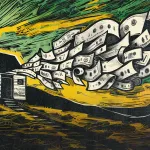“But what if in the future even one space was too much? Not long before Gorvy left Christie’s, he happened to post an image on his personal Instagram account of a 1982 [Jean-Michel] Basquiat portrait of the boxer Sugar Ray Robinson. He had 57,900 followers at that point. A goodly number but hardly earth-shattering. He posted the image just as he boarded for Hong Kong, then turned off his phone and settled in for the flight.
“Upon landing, Gorvy saw that he had messages from three collectors, in the United States, London and Asia enquiring about the painting. Within two days the American collector had bought it for a reported $24 million [R417,840,000 at the time of publishing]. From the buyer’s point of view, Gorvy later said, this was a total Instagram sale. And from the dealer’s point of view? Was it the harbinger of a whole new market? Or the beginning of the end of a market, as Gorvy knew it?” writes author and Vanity Fair contributing editor Michael Shnayerson in his 2019 book, BOOM: Mad Money, Mega Dealers, and the Rise of Contemporary Art , which follows the unhampered rise of the global art market from the mid-20th century onward, and wealthy megadealers whose wheeling and dealing played a key role in making that growth possible.
The incident he recounts in the above quote took place in November and December 2016, and the Gorvy mentioned is South African born art dealer Brett Gorvy, then Christie’s chairman and international head of post-war and contemporary art. At the time, news of the Instagram sale made headlines, both because it suggested the possibility of a future where collectors could buy such an expensive work from a tiny Instagram photo, and the price was more than three times the$7.3-million[R127,093,000 at the time of publishing] the work fetched at auction in 2007.
Thus far, even with the growth of online platforms such as Artsy, there is no clear evidence that the rise of online sales has a negative impact on galleries. If anything, many galleries have managed to use online platforms for a further boost to their offering. Certainly in South Africa, the past decade has marked continuous growth within the art industry.
However, the pandemic and the ensuing lockdowns have presented challenges for galleries, who have been unable to hold exhibition openings or collector dinners, which play an important role in the sale of art. Even now that they are open, there are still limitations as they can’t hold big events, and often operate on limited business hours.
Like many other industries, their online offering became increasingly important for galleries during this time.
“The online space has been working out for us. It will never replace gallery dinners, openings, and those kinds of things, and we all long for a time when we can go back to that, but what has been amazing is that all of a sudden people we know all over the world can attend an event we’re organising online, such as an artist book launch we did, for example.
“It’s also opened a new way of working that makes some of these events more accessible. Now we have curators and collectors from around the world attending these virtual gallery events. I think we all feel a bit silly that we didn’t think of doing stuff like this more often before. Because there’s no reason we couldn’t have, that technology has been around for a couple of years already,” says Joost Bosland, director at the Stevenson gallery, which has locations in Cape Town and Johannesburg.
Locally, Stevenson were among the first to launch an exhibition completely online, when they opened Thenjiwe Niki Nkosi’s exhibition on their website and on the Instagram page on 26 March, a day before South Africa’s lockdown went into effect.
“Even the moment lockdown started, our gallery never went to sleep. In fact, we turned it up 200% so that we could get into contact with the artists to see what they were able to do in a limited space as many didn’t have access to their studios,” says Heinrich Groenewald, head of exhibitions at SMAC gallery, which has three locations: Woodstock and Stellenbosch in the Western Cape, and Johannesburg. New additions to their online offering include podcasts as well as the “Artist Rooms” where viewers can watch a video on the exhibition as well as read up on the exhibition.
“Through this, we’ve actually had the opportunity to still make sales. These systems have made it possible for us to connect intimately with our clients. And we’ve been able to support the ecosystem of the arts, because we could still commission writers and we could still get photographers in and we are also connecting with young curators to do interviews for our podcasts which have become a cool way to kind of tune into the thoughts behind an artist’s practice,” explains Heinrich.
Ashleigh McLean from WhatIfTheWorld gallery in Cape Town says their gallery has taken a closer look at the search engine optimisation:
“We did a lot of optimisation on Google search words and things like that, whereas previously if we had a painting or something listed on Artsy for example, it would state the name of the artist, the title of the work and a brief description. Now we’ve looked at each one of these artworks and come up with keywords to describe everything about the work, so that if somebody Googles a very wide net to search for something, then that work will come up and hopefully drive a sale. Because collectors search for artworks using keywords.”
Both McLean and Stevenson’s Bosland note that sales have been a bit slower but not as bad as expected, and the overheads have also been lower. “I was really worried that it was going to be like Armageddon, and everything was just going to crumble into nothing, because ultimately we’re selling a luxury item, one that people can consume for free without buying it. But it’s been a lot better than I thought it was going to be. We’ve also taken relatively big salary cuts, and managed to secure rebates on our rental for the gallery space,” says McLean.
Meanwhile, Bosland notes the savings from not having openings and not paying for travel and booth space at art fairs, as most have gone online, as a saving that softened the impact of slower sales.
Beyond the galleries, South Africa also has a number of annual art fairs that are still coming up for the second half of 2020, such as Art Joburg, the Turbine art fair, and Latitudes, a new addition to the art fair landscape that was launched in 2019. Art Joburg has moved its fair online, running from 4 to 23 September. Turbine art fair is also hosting the fair and accompanying programme online from 27 August until 2 September.
…while developing the online art offering has resulted in lessons for galleries and art fairs that many will take forward and apply in improving their offering, Stevenson’s Bosland is adamant that this will not replace the real-life experience…
Latitudes, on the other hand, has taken the step of shifting its entire model from an annual art fair to becoming an art e-commerce and editorial website that is operational throughout the year.
Says Latitudes co-founder Lucy MacGarry: “When lockdown happened, we were still in the midst of planning our physical event, which was going to be in September on the rooftop of Sandton City, and we were actually partnering with the Handmade Contemporary fair (HMC). So you would have one ticket and then go forth. But obviously when we realised that that wouldn’t be possible, we started to think about ways to recreate that online.”
MacGarry explains that since launching last year, an online marketplace has been on the cards for Latitudes; however, the pandemic has accelerated those plans:
“International collectors have much more access to the contemporary art market in South Africa and the continent than they did 10 years ago; but it’s still a little bit ambiguous for people that haven’t travelled here or those who don’t have the network and don’t know which galleries to go to and that kind of thing. So we decided to actually extend the fair into an all year round online platform that showcases galleries, studios, curators, and independent artists; which would also function as the ultimate introduction to the local art ecosystem.”
However, while developing the online art offering has resulted in lessons for galleries and art fairs that many will take forward and apply in improving their offering, Stevenson’s Bosland is adamant that this will not replace the real-life experience:
“I think it is a necessary evil, and we’ve definitely taken it very seriously. And I think one thing our world has learnt is how to present exhibitions online; as an industry we were very far behind almost every other industry. So that’s positive, and the online space will continue to grow as a research and transaction space
“But I also think as an art world we’ve developed a kind of a Stockholm Syndrome; we’re being held hostage by online because it’s the only thing we can do and we’ve sort of fallen in love with it. That doesn’t actually mean it’s ideal or that it’s the future, as a way of experiencing art. It’s just a temporary placeholder; a band aid. When you’re reading a book online, you lose a lot less by transitioning to digital. But when it comes to art you lose more. Art is about scale, it’s about surface, it’s about texture. One loses that encounter online.” DM/ML


















